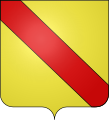House of Ligne
| House of Ligne | |
|---|---|
 | |
 | |
| Current region | Belgium |
| Place of origin | Ligne in Belgium |
| Distinctions | Princes of Ligne |
| Estate(s) | Château de Belœil |

Template:Princely Family of Ligne
The House of Ligne is one of the oldest Belgian noble families, dating back to the eleventh century.[1] Its name comes from the village in which it originated, between Ath and Tournai. The lords of Ligne belonged to the entourage of the Count of Hainaut at the time of the Crusades.[2]
With the battle of Bouvines in 1214, they were described as "great name and men of honour" by the chroniclers of the time. Their progressive rise in the nobility began as barons in the twelfth century, then counts of Fauquemberg and princes of Épinoy in the sixteenth century, princes of Amblise in 1608.[1] The family became Imperial counts on 18 December 1544, Lamoral I receiving from Rudolf II, Holy Roman Emperor, the title Prince of the Holy Roman Empire as Prince de Ligne on 20 March 1601,[1] for all of his agnatic descendants, male and female.
Compensation for loss of the Imperial County of Ligne (Fagnolles, since that barony had become seat of the county in 1789) as a result of the Peace of Lunéville consisted of substitution of the secularized Imperial abbey of Edelstetten, with an individual vote guaranteed in the Imperial College of Princes in 1803.[1] That principality was, however, sold to Prince Nikolaus Esterházy on 22 May 1804,[1] before the abolition of the Holy Roman Empire, of which Edelstetten had been a constituent Imperial state, in 1806.
The style of Highness was confirmed for all members of extant branches of the family on 31 May 1923, and the titles of Prince d'Amblise and Prince d'Epinoy recognized for the head of the house on 22 October of the same year by the Belgian Crown.[1]
There have been cadet branches of this house: Barbançon, Barbançon-Arenberg, Moy, Ham and Arenberg.
Abbots and abbesses
Within this house, there were the following abbots and abbesses:
- Gérard de Ligne (†1270) Abbot de Cambrai
- Mahaut de Ligne (c. 1275) Abbess d'Epinlieu
- Marie de Ligne (c. 1500) Abbess de Mons
- Marie de Ligne (c. 1550) Abbess de Cambrai
- Catherine de Ligne (†1581) Abbess de Thorn (La Thure)
- Lamoral I, 1st Prince of Ligne and of the Holy Roman Empire 1601-1624 (1563-1624)
- Florent de Ligne, 1st Prince d'Amblise 1608-1622 (1588-1622)
- Albert Henri, 2nd Prince 1624-1641 (1615-1641)
- Claude Lamoral I, 3rd Prince 1641-1679 (1618-1679)
- Henri Louis Ernest, 4th Prince 1679-1702 (1644-1702)
- Antoine Joseph Ghislain, 5th Prince 1702-1750 (1682-1750)
- Claude Lamoral II, 6th Prince 1750-1766 (1685-1766)
- Charles-Joseph, 7th Prince 1766-1814 (1735-1814)
- Prince Louis-Eugene de Ligne (1766-1813)
- Eugène I, 8th Prince 1814-1880 (1804-1880)
- Prince Henri Maximilien de Ligne (1824-1871)
- Louis, 9th Prince 1880-1918 (1854-1918)
- Ernest, 10th Prince 1918-1937 (1857-1937)
- Eugène II, 11th Prince 1937-1960 (1893-1960)
- Baudouin, 12th Prince 1960-1985 (1918-1985)
- Antoine, 13th Prince 1985-2005 (1925-2005)
- Michel, 14th Prince 2005–present (born 1951)
- Henri Antoine, Hereditary Prince of Ligne (born 1989)
- Prince Wauthier de Ligne (born 1952)
- Prince Philippe de Ligne (born 1977)
- Prince Antoine de Ligne (born 1959)
- Prince Louis de Ligne (born 2003)
- Michel, 14th Prince 2005–present (born 1951)
- Eugène II, 11th Prince 1937-1960 (1893-1960)
- Prince Charles-Joseph de Ligne (1837-1914)
- Prince Henri Florent Lamoral of Ligne (1881-1967)
- Prince Jean Charles of Ligne-La Trémoïlle (1911-2005)
- Prince Charles-Antoine Lamoral of Ligne-La Trémoïlle (born 1946), see below
- Prince Jean Charles of Ligne-La Trémoïlle (1911-2005)
- Prince Henri Florent Lamoral of Ligne (1881-1967)
- Prince Henri Maximilien de Ligne (1824-1871)
- Eugène I, 8th Prince 1814-1880 (1804-1880)
- Prince Louis-Eugene de Ligne (1766-1813)
- Charles-Joseph, 7th Prince 1766-1814 (1735-1814)
- Henri Louis Ernest, 4th Prince 1679-1702 (1644-1702)
- Florent de Ligne, 1st Prince d'Amblise 1608-1622 (1588-1622)
Other members of the House of Ligne
Claimants to the kingdoms of Jerusalem, Cyprus, Armenia, and Naples:
- Prince Charles-Antoine Lamoral of Ligne-La Trémoïlle (born 1946), see above
- Prince Edouard Lamoral Rodolphe de Ligne-La Trémoïlle (born 1976), heir apparent
- Prince Charles Joseph Malcolm de Ligne-La Trémoïlle (born 1980)
- Prince Amadeo Joseph Gabriel de Ligne-La Trémoïlle (born 2012)
Arms of the House of Ligne
The coat of arms of the family is blazoned as Or a bend gules.[5]
-
Heraldic shield of the House of Ligne
-
Arms with princely mantle
-
Arms of the branch of Barbançon
-
Arms of the branch of Ham
-
Arms of the branch of Moÿ
Further reading
- Herpin, Clara Adèle Luce (1887). Memoirs of the Princesse de Ligne. R. Bentley. ASIN B00085JKTO.
Notes
- ^ a b c d e f Genealogisches Handbuch des Adels, Fürstliche Häuser XIV. "Ligne". C.A. Starke Verlag, 1991, pp. 495-500. ISBN 978-3-7980-0700-0.
- ^ "Ducal and princely houses of Belgium - Belgium Travel Guide - Eupedia". Eupedia.
- ^ Marek, Miroslav. "ligne/ligne2.html". genealogy.euweb.cz.[self-published source][better source needed]
- ^ Marek, Miroslav. "ligne/ligne3.html". genealogy.euweb.cz.[self-published source][better source needed]
- ^ Arnaud Bunel. "Maison de Ligne". heraldique-europeenne.org.





